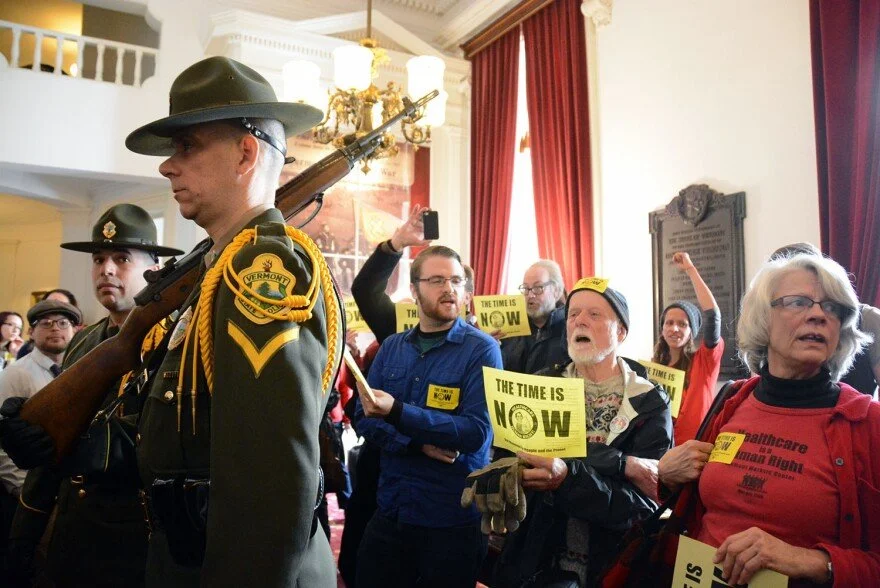In Vermont, single-payer health care movement presses on
In 2015, single-payer supporters disrupted Gov. Peter Shumlin's inaugural address. Advocates say the movement for a universal, publicly-financed health care system is alive and well in 2022.
Eleven years after Vermont passed the nation’s first-ever single-payer health care plan, the advocates behind that movement are still fighting for the creation of a universal, publicly-financed health care system.
A decade ago, if you dropped by the Vermont Statehouse on any given day, you’d find lawmakers toiling away on one of the biggest state-level health care reform initiatives the country had ever seen. And for advocates, the dream of single-payer seemed nearly in hand.
All that changed on Dec. 17, 2014, when then-Gov. Peter Shumlin pulled the plug on his single-payer plan.
In the years that have passed, the health care reform movement that fueled Shumlin’s proposal hasn’t gone away. The Legislature’s appetite for moving to a publicly-financed system, however, has diminished.
“I haven’t been able to see the numbers to show how that works, and I have concerns,” House Speaker Jill Krowinski said recently.
The seeds of today’s single-payer movement were to some extent sewn in the aftermath of the last big push for change in Vermont. A protest at Shumlin’s inaugural address in early 2015 – less than a month after he announced he was pulling the plug on his single-payer plan – showed the tenacity of the movement.
Burlington Rep. Brian Cina said it also demonstrated the dejection that Shumlin’s reversal had triggered.
“When Peter Shumlin disappointed everyone, it was a crushing blow, it really set things back,” Cina told VPR.
Cina was among the thousands of Vermonters who played a role in that movement.
“I volunteered on Shumlin’s campaign … because Democratic party and Peter Shumlin, at that time, after Jim Douglas, were pushing for universal health care in the state, and a lot of us believed in that,” he said.
The shelving of single-payer is a big reason that Cina decided to get into politics.
“It was my hope running for office that I could fight from the inside to get closer to universal health care,” he said.
Cina has introduced legislation that charts the path to single-payer anew. The bill, called H.276, has more than 40 sponsors. But in the 12 months since he drafted the bill, it hasn’t gotten a vote in committee, let alone progressed to the floor.
VPR has heard from more than a dozen people about this topic, including Lee Russ, of Bennington, asking versions of the same basic question: “How do you explain a bill on an important issue like health care that has 44 co-sponsors being unable to get a discussion in the committee?”
Before getting the answer to Russ’ question, it might be useful to understand what H.276 would do.
Taylor Dobbs / VPR
Long-time single-payer advocate Dr. Deb Richter explains: “It would essentially phase in universal health care, in other words, everyone in the system, publicly funding it for everyone, so it’s sort of a form of Medicare or Medicaid, but everyone included."
H.276 would start that phasing-in process with universal primary care. And then, over the next 10 years, Richter said, services including hospital care, vision and dental would slowly get folded into the universal system.
“Eventually we would have the whole system, a comprehensive system, where you would no longer need private insurance for anything,” Richter said.
For advocates like Judy Olinick, a Middlebury resident who also asked VPR about prospects for H.276, Cina’s bill addresses the root problem Vermont needs to solve.
“Any sort of well-to-do, well-off democracy just has no excuse for not funding health care for everyone, publicly funding it,” she said.
Like Lee Russ, Richter said she’s at a loss for why Democratic leaders in Montpelier aren’t pursuing H.276 with more vigor.
“I do think you should ask leadership, because I have wondered that myself,” she said. “To me, this makes such perfect sense.”
House Speaker Jill Krowinwski is no stranger to the single-payer concept.
She was appointed to the Legislature in 2012, when momentum for publicly-financed health care seemed unstoppable.
Even then, however, Krowinski said she was skeptical. During her work at Planned Parenthood, she said she’d gained insights into the complexity of the state’s $6 billion health care system.
“I had some hesitation about whether we could pull this off, because it was so huge,” she said.
Regardless of the merits of H.276, Krowinski said the pandemic has effectively halted any near-term prospects for its passage.
“In order to build that new system, I think we have to wait until we get through the worst of the pandemic, because we need our health care workforce to be part of that conversation, and they just can’t do that right now,” she said.
But even after Vermont is on the other side of COVID-19, Krowinski said she has her doubts.
“Because when we went and did it alone, unfortunately it didn’t work,” she said.
There was a reason Shumlin abandoned the single-payer proposal. The team of experts he'd assembled to create the program discovered that the system would require far more in the way of public revenues than they'd initially anticipated.
And according to his estimates, generating those revenues would have included an 11.5% increase in the payroll tax on businesses, and a 9% increase in the state income tax on workers.
Single-payer proponents argued for a more “progressive” funding plan that included a graduated payroll tax, to soften the effect on small businesses, as well as a tax on wealth and investment earnings.
They also said that new taxes would almost entirely replace the premiums, co-pays and deductibles and that businesses and individuals were paying for health insurance.
And an analysis by Harvard economist William Hsiao projected that, under a single-payer framework, Vermont would lower overall health care spending by $1 billion annually within a decade of its implementation - savings he recommended the state use to bolster primary care.
Krowinski said a "Medicare for All" bill from Washington, D.C. would be the most effective — and least economically disruptive — way to transform how health care is financed.
Ellen Schwartz, with the Vermont Workers’ Center, isn’t holding her breath on Congress.
“We can’t wait for the federal government,” she said. “The failure of Build Back Better to pass shows us where the feds are at.”
The Workers’ Center was at the forefront of the single-payer movement 10 years ago. And it hasn’t let up in the meantime. But Schwartz says the organization has some concerns with the approach outlined in H. 276.
“Our concern about 276 is about the long implementation period,” she said.
The longer the implementation period, Schwartz added, the likelier the process will get derailed along the way, as it did in 2014.
Rep. Brian Cina says lack of strategic alignment among single-payer advocates is one reason the movement has stalled.
“And so there’s disagreement about how to get toward a publicly-financed universal health care option — that’s part of the problem here,” Cina said.
Richter said that if elected leaders demonstrated they were serious about moving forward on single-payer, then those disagreements would quickly dissolve. Lack of leadership on the issue, she said, might be the missing ingredient right now.
“I mean love him or hate him, Gov. Shumlin did that. He led on this issue, he ran on this issue,” Richter said. “Unfortunately pulled out of this thing too soon.”
Richter, Schwartz and Cina all say that advocates are ready as ever to support leaders that are willing to pick up the single-payer baton.



